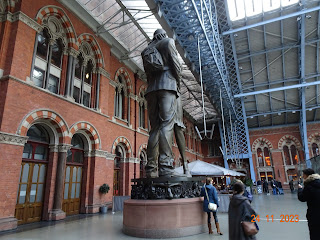St. Pancras Hotel
Unfortunately, when I get to St. Pancras station, I'm usually in a hurry to catch a train, either from there, from King's Cross across the road, or Euston, a brisk 5 minute walk away.
In wood and glass and iron and stone.
There was almost certainly a church here before the Norman Conquest of 1066. There is no church mentioned in the Domesday Book, but the name is used to refer to property held by the canons of St Paul's Cathedral, so it seems clear that there was a church here by that time. The church possessed a 6th century stone altar said to have been used by St Augustine.
The first documentary record comes from a pair of deeds dated between 1160-1180 in which Ralph de Kentewode confirms grants of land to the church of St Pancras. In 1181 it was given to the Chapter of St Pauls and the parish tithes were used to support a hospital within the Cathedral.
In the reign of Edward VI (c. 1549) the vicar was a reformer named John Bedstow, who had the peculiar habit of preaching from the branches of a tall tree in the churchyard and saying Mass from a tomb inside the church rather than from the high altar. In the late Elizabethan period it was described as being 'all alone, as utterly forsaken, old and weather-beaten', and in the 17th century it was said to be 'in the fields remote from any house' - something which is hard to imagine today!
By the Civil War, it was utterly deserted, so it comes as no surprise that in 1642 Parliament instructed that the 'deserted church of Pancras' should be used as a lodging for 50 army troopers. It was around this time that the 6th-century altar stone went missing.
The church was rarely used during the 18th century except for burials. When a new church was built in Euston Road in 1822 the Old Church lost its parochial status and became a chapel of ease.
By 1848 the medieval building, which had remained scarcely
altered since the 12th century, was in dire condition. Help was at hand; as the
City of London expanded in the middle of the 19th century the isolated area
north of the old city walls was swallowed up by new development and the
decrepit church was no longer isolated at all, but surrounded by the growing
city, and the growing population needed churches.
The church was completely restored by the architect AD Gough,
who swept away most of the medieval structure, tore down the tower and removed
the south porch. When workmen dug under the tower foundations they discovered
the 6th-century altar stone, along with the medieval church plate. Presumably,
these valuables had been hidden to prevent damage during the time the church
was taken over by the Parliamentarian soldiers.
The new building was designed in 12th-century style, with completely new doorways and windows. Gough did retain a section of the north wall, which has been left exposed on the interior so that you can see the 12th-century stonework, which incorporates Roman bricks and pieces of tile.
Soane never got over his wife’s death on 22 November 1815 although he lived until 1837. He was one of the most renowned architects of his day – creator of monumental public buildings including the Bank of England, churches, and country houses, as well as an avid collector of fragments of older buildings including Old St Paul’s cathedral. He blamed her death on the shock of discovering that their son George was the author of some malevolent anonymous reviews of his work.
The Hardy Tree was named for the writer, who stacked gravestones around the base of the ash when both man and plant were young in the 1860s.
The tree was surrounded by dozens of headstones that were placed at its base while engineering works were being undertaken on a railway line. It became a prominent image of life among death.
Thomas Hardy, not yet the celebrated writer he would become, was employed as a young architect in the office of Arthur Blomfield, in Covent Garden, London. The firm got the commission from the bishop of London to disinter a large number of graves from Old St Pancras cemetery. The Midland Railway was about to thunder its way through to what is now the Kings Cross–St Pancras station complex and it needed the consecrated earth for its rails.
Hardy received the instruction for mass exhumation and decent reburial elsewhere. The church’s website called the tree a “monument to the railway encroachments of the 19th century”.
And.......he wrote a poem
The Levelled Churchyard
Coade stone soon became popular with sculptors, as it allowed them to create finely detailed ornamentation on buildings. (The exact formula of Coade stone was kept secret and is commonly thought to have died with its inventor, Eleanor Coade, though in fact it was rediscovered in the 1990s.
John Charles Felix Rossi was commissioned to produce eight caryatids, sculpted female figures that serve as architectural supports. (In other words, really fancy pillars.)
Rossi spent three years sculpting the caryatids, only to come across a problem just before he was set to install them at the church. Turned out he had made them too tall to fit between the platforms on which they were to stand and the roof they had to support. Determined that his work would not be wasted due to an error in measurements, Rossi instead cut out part of the torso of each sculpture. The caryatids’ flowing robes enabled him to partially disguise his surgery.
Perhaps the biggest clue to his last-minute adjustments is that the legs of each caryatid are definitely disproportionately long.










.jpg)



























No comments:
Post a Comment